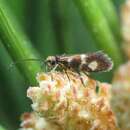Distribution
provided by EOL authors
According to Heath (1996) and Karsholt (2004) M. aureoviridella has been found in Italy, Switzerland, Germany, Austria, Poland, Slovenia and Slovakia. The records from Greece (Heath 1996, Karsholt 2004) and from Romania (Karsholt 2004) seem to be doubtful. A series of females from the Dinarian mountains remains of uncertain taxonomic status too (Zeller-Lukashort, Kurz & Kurz 2002).
The species is quite abundant in the northern and southern calcareous Alps, where it occurs mainly from 900 up to 2300 m a.s.l. (occasionally also lower, Kurz et al., 2009). In other upland areas (Germany: Harz; Switzerland and France: Jura) it may be found as low as 300 m a.s.l. (Kurz et al. 2009).
Description of adults
provided by EOL authors
Examined: 10 males, 27 females. Forewing length: male 3,4 - 3,9 mm; female 3,6 - 4,7 mm. Head black-brown; vestiture of hair-like scales on the head rusty yellow to dirty white; antennae golden brown, purple at the base, 4/5 (male), respectively, 4/7 (female) of forewing length; thorax golden, posteriorly purple violet; tegulae bronzy golden to purple violet, bluish in the posterior part; forewing bronzy golden to reddish golden, a purple violet spot near the base at the costa, basally and between the fasciae mixed with purple scales, sometimes also completely purple to purple violet in the anterior half of the forewing; inner margin broad golden to bronzy golden from the base to the middle of the wing; markings more or less silvery golden to golden, indistinctly bordered: a fascia extending from costa across more than half of the forewing width at 1/5, sometimes poorly developed; a narrower, bent fascia across the entire width of the wing at 1/2, often narrowed in the anterior third, sometimes nearly completely interrupted; an elongated, more or less large spot at 3/4, usually not reaching the costa and the inner margin; a small bronzy golden costal spot at 3/4, sometimes very ambiguous; fringe bronzy golden to whitish bronzy golden; hindwing bronzy golden, more or less with a purple tinge; fringe lightly bronzy golden; legs and abdomen brownish, golden shining.
Remarks. A series of females from the Dinarian Mountains (Croatia) remains of uncertain taxonomic status. Superficially they resemble M. aureoviridella, but their wing markings are overall dark bronzy golden and very diffuse. Their ground colouration is more reddish to purple.
M. aureoviridella has often been described as "golden green", which is the translation of its Latin name. But the animals are mostly reddish golden and often show a more or less intense purple colouration, which is already stated in the original description by Höfner (1898).
Micropterix aureoviridella: Brief Summary
provided by wikipedia EN
Micropterix aureoviridella is a moth of the family Micropterigidae found in Austria, Germany, Italy, Poland, Slovakia, Slovenia and Switzerland. It was first described by Gabriel Höfner in 1898.
The wingspan is about 7 millimetres (0.28 in). Adults are on wing from the end of May to July. It prefers open and dry habitats on southerly facing slopes, margins of light spruce forest with interspersed rocks, margins of forest and scrubs in mountainous areas, as well as in elfin woodland. It has also been found in sub-alpine dwarf scrub.
The adults feed on some shrubs, including Pinus mugo.
- license
- cc-by-sa-3.0
- copyright
- Wikipedia authors and editors

